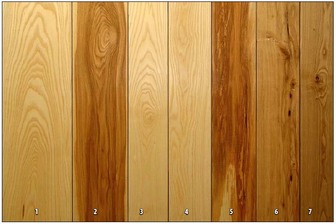 Purdue University - Extension - Forestry and Natural Resources
Purdue University - Extension - Forestry and Natural Resources
Got Nature? Blog
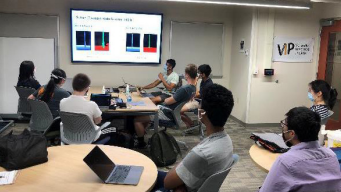 The Hardwood Tree Improvement & Regeneration Center (HTIRC) continues to share top forest research as scientists, experts and partners further the mission of tree improvement, management, and protection of hardwood forests. The most recent HTIRC Annual Report is now available and includes research, stakeholders and outreach:
The Hardwood Tree Improvement & Regeneration Center (HTIRC) continues to share top forest research as scientists, experts and partners further the mission of tree improvement, management, and protection of hardwood forests. The most recent HTIRC Annual Report is now available and includes research, stakeholders and outreach:
- Center for Advanced Forestry Systems (CAFS) 2021
- HTIRC Annual Meeting Highlights Potential for Digital Forestry
- Aerial Tree Inventory With LiDAR and UAS Images
- Monitor Stress Epidemiology
- Precision Management: Geo-referenced and Image-assisted Biometric Evaluation, Log and Lumber Processing Optimization with CT Scanning
- Improving Establishment Practices of Pure and Mixed Hardwood Plantations by Refining Soil Suitability Indices for Black Walnut
- Natural and Artificial Regeneration Growth Response of White Oak Across Light and Understory Competition Gradients (Year 3)
- Productivity-Diversity Relationships in Hardwood Plantation
Plus much more: HTIRC 2021 Annual Report.
If you would like to subscribe and receive the e-newsletter visit HTIRC e-Newsletter.
The mission of the HTIRC is to advance the science and application of tree improvement, management, and protection of hardwood forests, with emphasis in the Central Hardwood Forest Region (CHFR). They seek to develop research and technology-transfer programs that provide knowledge focused on the establishment and maintenance of sustainable, genetically diverse native forests and the development of highly productive woodlands that provide a wide array of products and services.
Other resources:
Tropical HTIRC
An Introduction to Trees of Indiana, The Education Store, Purdue Extension resource center
Native Trees of the Midwest, The Education Store
Shrubs and Woody Vines of Indiana and the Midwest, The Education Store
ID That Tree, Playlist, Subscribe to Purdue Extension – Forestry and Natural Resources YouTube Channel
A Woodland Management Moment, Playlist, Purdue Extension – FNR YouTube Channel
Investing in Indiana Woodlands, The Education Store
Forest Improvement Handbook, The Education Store
Finding help from a professional forester, Indiana Forestry & Woodland Owners Association
Matthew Ginzel, Professor in Entomology and Forestry and Director of Hardwood Tree Improvement and Regeneration Center (HTIRC)
Purdue University Department of Forestry and Natural Resources
The classic and trusted book “Fifty Common Trees of Indiana” by T.E. Shaw was published in 1956 as a user-friendly guide to local species. Nearly 70 years later, the publication has been updated through a joint effort by the Purdue Department of Forestry and Natural Resources, Indiana 4-H, and the Indiana Department of Natural Resources, and reintroduced as “An Introduction to Trees of Indiana.”
 The full publication is available for download for $7 in the Purdue Extension Education Store. The field guide helps identify common Indiana woodlot trees.
The full publication is available for download for $7 in the Purdue Extension Education Store. The field guide helps identify common Indiana woodlot trees.
Each week, the Intro to Trees of Indiana web series will offer a sneak peek at one species from the book, paired with an ID That Tree video from Purdue Extension forester Lenny Farlee to help visualize each species as it stands in the woods. Threats to species health as well as also insight into the wood provided by the species, will be provided through additional resources as well as the Hardwoods of the Central Midwest exhibit of the Purdue Arboretum, if available.
This week, we introduce the Blue Beech or Carpinus caroliniana.
The blue beech, also known as the American hornbeam, musclewood or the water beech, is an understory tree that stands out due to its gray bark and striations that resemble muscles and sinews as well as its doubly toothed leaves.
The small tree, which typically grows to a height of 20 to 35 feet, has oblong leaves with doubly toothed leaf margins, arranged alternately on very fine twigs. Lower leaf veins are seldom forked. The fruit is in clusters, consisting of small, seed-like nuts on small, three-lobed leaves. It’s bark and fruit help differentiate blue beech from its close relative, the ironwood.
Blue beech’s natural range is the majority of the midwestern and eastern United States, reaching as far south as Texas.
For full article and photos view Purdue Forestry and Natural Resources News: Trees of Indiana: Blue Beech.
Other Resources:
Beech – Hardwood Lumber and Veneer Series
Fifty Trees of the Midwest app for the iPhone
Native Trees of the Midwest, The Education Store, Purdue Extension’s resource center
Shrubs and Woody Vines of Indiana and the Midwest
ID That Tree YouTube playlist
Woodland Management Moment YouTube playlist
Investing in Indiana Woodlands, The Education Store
Forest Improvement Handbook The Education Store
Wendy Mayer, FNR Communications Coordinator
Purdue University Department of Forestry and Natural Resources
Lenny Farlee, Sustaining Hardwood Extension Specialist
Purdue University Department of Forestry and Natural Resources
The classic and trusted book “Fifty Common Trees of Indiana” by T.E. Shaw was published in 1956 as a user-friendly guide to local species. Nearly 70 years later, the publication has been updated through a joint effort by the Purdue Department of Forestry and Natural Resources, Indiana 4-H, and the Indiana Department of Natural Resources, and reintroduced as “An Introduction to Trees of Indiana.”
The full publication is available for download for $7 in the Purdue Extension Education Store. The field guide helps identify common Indiana woodlot trees.
Each week, the Intro to Trees of Indiana web series will offer a sneak peek at one species from the book, paired with an ID That Tree video from Purdue Extension forester Lenny Farlee to help visualize each species as it stands in the woods. Threats to species health as well as also insight into the wood provided by the species, will be provided through additional resources as well as the Hardwoods of the Central Midwest exhibit of the Purdue Arboretum, if available. 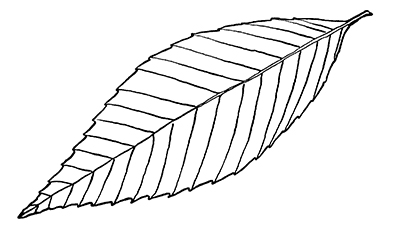
This week, we introduce the beech, or Fagus grandifolia.
The Beech is easily identified by its smooth gray bark and its simple leaves, which feature straight-line veins from the midrib to the small teeth on the margin. Beeches produce a 3/4-inch long fruit covered in spines, which typically holds two triangular-shaped nuts.
American beech is a shade tolerant species found in the understory often on moist but well-drained soils, that also reaches up into the forest canopy at around 70 to 80 feet tall. Beech is found throughout the Great Lakes region as well as the central and southeastern United States.
Beech is used to make items varying from wooden clothes pins to brush banks, handles and woodenware. Due to its strength and ease of turning, it is also used for chair production. Flooring, railroad ties, pallets and container veneer are other uses for this species.
For full article and photos view Purdue Forestry and Natural Resources: Trees of Indiana: Beech.
 View the Purdue Online Tour: Hardwoods of the Central Midwest and find out beech species workability, strength, if it can be steam bent, drying details and much more.
View the Purdue Online Tour: Hardwoods of the Central Midwest and find out beech species workability, strength, if it can be steam bent, drying details and much more.
Resources:
Beech – Hardwood Lumber and Veneer Series
Fifty Trees of the Midwest app, for the iPhone
Native Trees of the Midwest, The Education Store, Purdue Extension’s resource center
Shrubs and Woody Vines of Indiana and the Midwest, The Education Store, Purdue Extension’s resource center
ID That Tree, YouTube playlist
Woodland Management Moment, YouTube playlist
Investing in Indiana Woodlands, The Education Store, Purdue Extension’s resource center
Forest Improvement Handbook, The Education Store, Purdue Extension’s resource center
Wendy Mayer, FNR Communications Coordinator
Purdue University Department of Forestry and Natural Resources
Lenny Farlee, Sustaining Hardwood Extension Specialist
Purdue University Department of Forestry and Natural Resources
Spring is in full bloom and trees are beginning to look green again. Learning how to identify trees in yards, neighborhoods and local parks provides insight into the diversity and relationships found in nature. Lenny Farlee, Purdue Extension Forester, shares how to identify trees native to Indiana.
Leaf Arrangement
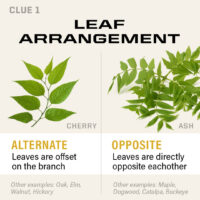 Leaf arrangement is one of the first characteristics to check for on deciduous (trees that lose their leaves annually) broadleaved trees that make up the majority of our native species. The two arrangements we commonly find are alternate and opposite.
Leaf arrangement is one of the first characteristics to check for on deciduous (trees that lose their leaves annually) broadleaved trees that make up the majority of our native species. The two arrangements we commonly find are alternate and opposite.
Opposite arrangement means the leaves are held on the twig directly opposite of one another. Alternate leaf arrangement means the leaves are arranged on the twig in an offset manner. We have one leaf, then another in a zig-zag or spiral fashion.
There are only a few native tree families with opposite leaf arrangements: Maple, Ash, Dogwood, Catalpa, Buckeye. You can remember these from the anacronym MAD Cat Buck – Maple, Ash, Dogwood, Catalpa, Buckeye. Almost all other native trees have alternate leaf arrangements.
Leaf Types
The next characteristic to check is if the tree has simple or compound leaves. To do this, we need to understand the difference between a leaf and a leaflet. A leaf has a bud at the base of the stem. The entire structure after the bud is the leaf.
A simple leaf is singular and never divided into smaller leaflets. A compound leaf consists of several or many leaflets joined to a single stem after the bud.
Resources:
ID That Tree, Playlist, Purdue Extension – Forestry and Natural Resources YouTube Channel
A Woodland Management Moment, Playlist, Purdue Extension – FNR YouTube Channel
Purdue Extension, website
Shrubs and Woody Vines of Indiana and the Midwest, The Education Store, Purdue Extension Resource Center
Native Trees of the Midwest, The Education Store
Investing in Indiana Woodlands, The Education Store
Forest Improvement Handbook, The Education Store
Purdue College of Agriculture News
Lenny Farlee, Sustaining Hardwood Extension Specialist
Purdue University Department of Forestry and Natural Resources
In this HEE Prescribed Fire video, Charlotte Owings, project coordinator on the Hardwood Ecosystem Experiment (HEE) explains the forest management technique of prescribed fire and how it is being utilized on the HEE.
What is HEE?
The focus of forest science is increasingly shifting to the management of forests as complex systems rather than as simple agricultural landscapes—with a much greater appreciation for the interactive ecosystem processes. In addition, now for many forest landowners, the ecological value of their land is at least as important as the economic return. It is, therefore, vital to understand how forest management affects not only timber production, but also the overall function of forested ecosystems.
The Hardwood Ecosystem Experiment (HEE) is a long-term, large-scale experimental study of forest management and its impacts. The project was initiated in 2006 with partners including: Ball State University, Drake University, Indiana State University, Purdue Entomology, Indiana Department of Natural Resources (IN DNR), and the Indiana Chapter of the Ruffed Grouse Society.
For information about study sites, harvesting treatments, sampling design, and more, see our Study Design page and US Forest Service General Technical Report NRS-P-108, The Hardwood Ecosystem Experiment: A Framework For Studying Responses to Forest Management.
Resources
Hardwood Ecosystem Experiment, Website
Hardwood Ecosystem Experiment (HEE), YouTube Playlist, Purdue Extension–Forestry and Natural Resources (FNR)
Ask an Expert: Hardwood Ecosystem Experiment (HEE) Birds and Salamander Research, Video, Purdue Extension-FNR YouTube Channel
Hardwood Ecosystem Experiment – Wildlife Responses to Timber Harvesting, The Education Store, Purdue Extension’s resource center
The Hardwood Ecosystem Experiment: Indiana Forestry and Wildlife, The Education Store
Charlotte Owings, Hardwood Ecosystem Experiment Project Coordinator
Purdue University, Department of Forestry and Natural Resources
The classic and trusted book “Fifty Common Trees of Indiana” by T.E. Shaw was published in 1956 as a user-friendly guide to local species. Nearly 70 years later, the publication has been updated through a joint effort by the Purdue Department of Forestry and Natural Resources, Indiana 4-H, and the Indiana Department of Natural Resources, and reintroduced as “An Introduction to Trees of Indiana.”
The full publication is available for download for $7 in the Purdue Extension Education Store. The field guide helps identify common Indiana woodlot trees.
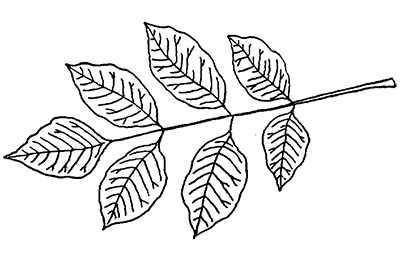 Each week, the Intro to Trees of Indiana web series will offer a sneak peek at one species from the book, paired with an ID That Tree video from Purdue Extension forester Lenny Farlee to help visualize each species as it stands in the woods. Threats to species health as well as also insight into the wood provided by the species, will be provided through additional resources as well as the Hardwoods of the Central Midwest exhibit of the Purdue Arboretum, if available.
Each week, the Intro to Trees of Indiana web series will offer a sneak peek at one species from the book, paired with an ID That Tree video from Purdue Extension forester Lenny Farlee to help visualize each species as it stands in the woods. Threats to species health as well as also insight into the wood provided by the species, will be provided through additional resources as well as the Hardwoods of the Central Midwest exhibit of the Purdue Arboretum, if available.
First up, we introduce the white ash or fraxinus americana.
The white ash, which is typically found on higher and drier sites than its cohorts in the ash family, has been threatened due to the invasive beetle called the emerald ash borer. This species features opposite leaf arrangement, compound leaves with seven to nine leaflets, and squatty terminal buds as well as a bud that dips down into the leaf scar, which resembles a smiley face. The bark is gray, has a corky feel, and features an interlacing network of ridges forming a diamond shape.
Among the Hardwoods of the Central Midwest, white ash is the best known and preferred species among the five ash species located throughout the eastern United States. The species is found from the Great Plains east and from southern Canada south, with the exception of the lower Mississippi River Delta and coastal plains areas.
White ash is very hard and firm and with a 12% moisture content, it is comparable to white and red oak as one of the strongest woods. The wood grain appears much like oak, but does not have the large rays seen on the quartered surface of oak.
Ash is used on exposed surfaces in furniture and cabinets and also for millwork and flooring. Due to its high strength in bending and high shock resistance, it is also used in athletic equipment such as baseball bats and tennis rackets.
The history, color and texture and wood properties of white ash are available in more detail on the Hardwoods of the Central Midwest page for the species.
For full article and photos view Purdue Forestry and Natural Resources News.
Other Resources:
Ash (pdf)- Hardwood Lumber and Veneer Series
Fifty Trees of the Midwest app for the iPhone
Native Trees of the Midwest, The Education Store, Purdue Extension’s resource center
Shrubs and Woody Vines of Indiana and the Midwest, The Education Store
ID That Tree, Purdue Extension-Forestry and Natural Resources (FNR) YouTube playlist
Woodland Management Moment, Purdue Extension-FNR YouTube playlist
Investing in Indiana Woodlands, The Education Store
Forest Improvement Handbook, The Education Store
Emerald Ash Borer puts trees on path to functional extinction, Purdue Agriculture News
Emerald Ash Borer, Purdue Entomology
Emerald Ash Borer University, Purdue Entomology
Emerald Ash Borer Management, Purdue Entomology
New tips for managing emerald ash borer, Purdue Landscape Report
Avoid deadly risk of dying ash trees with timely tree removal, Purdue Landscape Report
Wendy Mayer, FNR Communications Coordinator
Purdue University Department of Forestry and Natural Resources
Lenny Farlee, Sustaining Hardwood Extension Specialist
Purdue University Department of Forestry and Natural Resources
Purdue Forestry and Natural Resources’ extension efforts over the past two years amidst the COVID-19 pandemic were recognized in the Purdue Extension Specialist Quarterly newsletter.
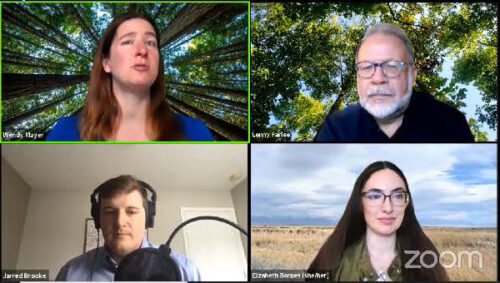 The transition to virtual content brought expertise across subject matter areas, ranging from forestry and wildlife, to aquatic sciences and entomology, to the masses in the form of several video series which collectively earned nearly 150,000 views.
The transition to virtual content brought expertise across subject matter areas, ranging from forestry and wildlife, to aquatic sciences and entomology, to the masses in the form of several video series which collectively earned nearly 150,000 views.
The FNR Extension team included: Jay Beugly, Jarred Brooke, Nick Burgmeier, Barny Dunning, Diana Evans, Lenny Farlee, Jason Hoverman, Liz Jackson, Brian MacGowan, Patrick McGovern, Wendy Mayer, Charlotte Owings, Lindsey Purcell, Bee Redfield, Shelby Royal, Bob Rode, Kara Salazar, Mike Saunders, Amy Shambach, Rod Williams, Mitch Zischke, as well as frequent Entomology contributors: Elizabeth Barnes, Cliff Sadof.
The feature in the fourth quarter newsletter begins:
“While Covid caused limitations on travel and in-person events nationwide, across Indiana, many were spending more time in outdoor recreational activities, hiking, bird-watching, hunting and fishing, or managing natural resources properties. Adjusting to the pandemic, the FNR team created an innovative and team-oriented instruction approach through skill-building in video production with coordinated connection and crosspromotion of resources.
“Forestry and Natural Resources (FNR) faculty, specialists, staff, and students, with invited partners across research and Extension, delivered 45-minute Ask an Expert Facebook Live programs for 35 weeks. Programs covered many FNR specialties: Animals & Insects (bats, bird, cicadas, coyotes, deer, fish, frogs, hellbenders, moles, pollinators, salamanders, snakes, toads, turtles, and wood pests); Plants & Ecosystems (invasive plant species, hardwood ecosystems, native grasses for wildlife, conservation tree planting, rainscaping, fall food plots, and selecting, planting and inspecting trees); and Management & Operations (prescribed fires, aquatic plant and pond management, and fish and wildlife management).
Resources:
Ask An Expert Playlist, Purdue Extension – Forestry and Natural Resources (FNR) YouTube Channel
ID That Tree Playlist, Purdue Extension – FNR YouTube Channel
A Woodland Management Moment Playlist, Purdue Extension – FNR YouTube Channel
Wildlife Habitat Hint Playlist, Purdue Extension – FNR YouTube Channel
Subscribe to the Purdue Extension – Forestry and Natural Resources YouTube Channel
Wendy Mayer, FNR Communications Coordinator
Purdue University Department of Forestry and Natural Resources
Diana Evans, Extension and Web Communication Specialist
Purdue University Department of Forestry and Natural Resources
 Henry Quesada, FNR professor, assistant director of Extension and Agriculture & Natural Resources (ANR) Program Leader, obtained a BS in Industrial Production Engineering from the Costa Rica Institute of Technology (Costa Rica TEC). He worked for a commercial printing company before coming to Purdue as MS and PhD student in the Department of Forestry and Natural Resources. After completing his graduate education, Henry worked as a faculty member for Costa Rica TEC where he focused on undergraduate teaching and engagement with industry and communities. In 2008 Henry joined the Department of Sustainable Biomaterials at Virginia Tech as an extension specialist. At Virginia Tech, Henry developed a national extension program to increase the utilization of renewable materials to mitigate climate change, improve industry competitiveness and enhance livelihoods in rural communities. At Purdue, Henry is the ANR Program Leader where his main responsibilities are to provide leadership, strengthen and build on and off-campus relationships, articulate and communicate the ARN program’s vision, and to create a collaborative environment that fosters a culture of innovation.
Henry Quesada, FNR professor, assistant director of Extension and Agriculture & Natural Resources (ANR) Program Leader, obtained a BS in Industrial Production Engineering from the Costa Rica Institute of Technology (Costa Rica TEC). He worked for a commercial printing company before coming to Purdue as MS and PhD student in the Department of Forestry and Natural Resources. After completing his graduate education, Henry worked as a faculty member for Costa Rica TEC where he focused on undergraduate teaching and engagement with industry and communities. In 2008 Henry joined the Department of Sustainable Biomaterials at Virginia Tech as an extension specialist. At Virginia Tech, Henry developed a national extension program to increase the utilization of renewable materials to mitigate climate change, improve industry competitiveness and enhance livelihoods in rural communities. At Purdue, Henry is the ANR Program Leader where his main responsibilities are to provide leadership, strengthen and build on and off-campus relationships, articulate and communicate the ARN program’s vision, and to create a collaborative environment that fosters a culture of innovation.
“At Virginia Tech, I was able to connect with the forestry industry and communities and helped support initiatives locally, regionally and nationally. In my new position at Purdue, I am excited to continue to explore innovations and partnerships in Indiana, a state with a diverse agriculture and lumber industry from row crops to local foods to livestock to hardwoods. I am an entrepreneur at heart and believe we have many opportunities to work with Indiana farmers to identify and reach new markets with existing and new products.”
View more about Dr. Henry Quesada: Purdue Extension News-New ANR Program Leader joins Purdue Extension.
Resources:
Agriculture & Natural Resources, Purdue Extension
Wood Products, Area of Interest, Purdue Extension – Forestry and Natural Resources (FNR)
Subscribe: Purdue Extension – FNR YouTube Channel
Hardwood & Woodland Upcoming Events, Purdue Extension FNR
Henry Quesada, FNR Professor, Assistant Directory of Extension and ANR Program Leader
Purdue Extension
Diana Evans, Extension and Web Communication Specialist
Purdue University Department of Forestry and Natural Resources
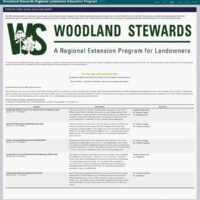 Many forest landowners miss opportunities to save on their income and property taxes. Even accountants and tax experts may not be aware of some of the provisions covering woodland ownership, timber sales income, and reforestation expenses. It can pay dividends to become familiar with some of the tax programs and policies that might save you money and inform how you execute your woodland management in the future.
Many forest landowners miss opportunities to save on their income and property taxes. Even accountants and tax experts may not be aware of some of the provisions covering woodland ownership, timber sales income, and reforestation expenses. It can pay dividends to become familiar with some of the tax programs and policies that might save you money and inform how you execute your woodland management in the future.
Several states offer programs that reduce property tax liability for woodland owners who meet certain requirements and enroll in and abide by the regulations of state forestland programs. These programs vary by state, but may provide a variety of benefits, including property tax liability reduction, forest management plans, and management assistance. Contact your state forestry or natural resources agency to see what may be available and if it meets your property management goals.
The sale of timber will generally trigger a tax bill, but knowing how timber is taxed and how to manage your tax liability can save you significant money in some cases. Your professional forester can help you navigate the tax issues related to selling timber, but becoming familiar with the ways you can manage your tax liability can help you plan now and into the future.
The Woodland Stewards Regional Extension Program for Landowners was developed by a collaborative team of forestry Extension professionals from eleven different organizations. This is the fourth year of the series and other webinars from the current and past series can be accessed on the Webinar Portal. A series beginning on January 18th will provide an introduction to the tax management topics you may encounter as a forest land owner.
All webinars will be held at 1:00pm Eastern time:
January 18th: Seeing the Forest for the Trees: An Overview of Forestry Taxes
January 25th: Basics of Timber Basis: Re(setting) the Table
February 1st: Timber Management Expenses and Deductions
February 8th: Keeping More of Your Timber Income Following a Timber Sale
February 15th: Coping with losses from Nature and Chance
Visit this website to sign up for these programs, Forestry Taxes: Learn, Plan & Save Money.
All webinars will be recorded and will be available a few days after the presentation, at the same link.
The National Timber Tax website is another resource to learn more about the tax rules and opportunities landowners may utilize. This site contains abundant resources, decision tools, and references to help you with your tax management planning.
Finally, keep good records of your expenses and activities. Tax law and policy can change, but having good records can help you adapt and support your management program.
Resources:
Tax Tips for Forest landowners for the 2023 Tax Year (169kb pdf), USDA, U.S. Forest Service, University of Georgia, University of Florida
Classified Forest and Wildlands Program , Indiana Department of Natural Resources: Division of Forestry
Find an Indiana Professional Forester, Indiana Forestry & Woodland Owners Association (IFWOA)
Determining Tax Basis of Timber, The Education Store, Purdue Extension’s resource center
How to Treat Timber Sale Income, The Education Store
Financial and Tax Aspects of Tree Planting, The Education Store
Lenny Farlee, Extension Forester
Purdue University Department of Forestry and Natural Resources
Hardwood Improvement & Regeneration Center (HTIRC)
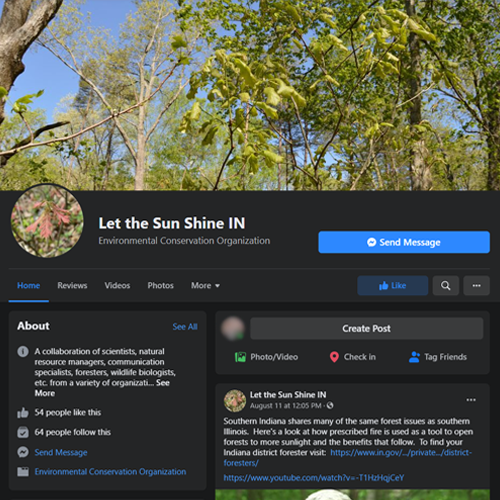 Let the Sun Shine Indiana is a new Facebook page that has resources for landowners and natural resource managers along with woodland lovers. With commitments to sustain the health and diversity of our forests, grasslands and wildlife for future generations, this collaboration will be sharing educational data, problem-solving and management practices.
Let the Sun Shine Indiana is a new Facebook page that has resources for landowners and natural resource managers along with woodland lovers. With commitments to sustain the health and diversity of our forests, grasslands and wildlife for future generations, this collaboration will be sharing educational data, problem-solving and management practices.
This collaboration is made up of scientists, natural resource managers, communication specialists, foresters, wildlife biologists, etc. from a variety of organizations, universities and agencies across Indiana, who share a common goal – restore southern Indiana’s open oak woodlands – because with the sun comes life.
Resources:
ID That Tree, Purdue Extension – Forestry and Natural Resources YouTube Channel
A Woodland Management Moment, Purdue Extension – FNR YouTube Channel
Woodland Stewardship for Landowners, Purdue Extension – Forestry and Natural Resources YouTube Channel
Shrubs and Woody Vines of Indiana and the Midwest, The Education Store, Purdue Extension Resource Center
Native Trees of the Midwest, The Education Store
Investing in Indiana Woodlands, The Education Store
Forest Improvement Handbook, The Education Store
Marion Mason, Public Affairs Specialist, Forest Service
Hoosier National Forest
Recent Posts
- Tax Information For Woodland Owners
Posted: January 25, 2024 in Forestry, How To, Timber Marketing, Woodlands - Forest Management for the Private Woodland Owner – SIPAC
Posted: November 17, 2023 in Forestry, How To, Invasive Plant Species, Timber Marketing, Woodlands - HTIRC Protecting Our Hardwood Forests
Posted: August 2, 2023 in Forestry, Timber Marketing, Woodlands - Check Out the Indiana Woodland Steward Newsletter
Posted: July 13, 2023 in Forestry, Timber Marketing, Wildlife, Wood Products/Manufacturing, Woodlands - Natural Resources University Podcasts Earn ANREP Gold Award
Posted: April 14, 2023 in Podcasts, Ponds, Timber Marketing, Wildlife, Woodlands - 100 Year Project Newsletter, Hardwood Ecosystem Experiment (HEE)
Posted: March 8, 2023 in Forestry, Timber Marketing, Wildlife, Woodlands - Indiana Woodland Steward, Your Forest and Wildlife Resource
Posted: March 7, 2023 in Forestry, Timber Marketing, Wildlife, Wood Products/Manufacturing, Woodlands - Forest Landowners Will Want to View U.S. Forest Service Resource
Posted: February 9, 2023 in Forestry, How To, Timber Marketing, Woodlands - Conservation Tree Planting: Steps to Success
Posted: February 3, 2023 in Forestry, Timber Marketing, Webinar, Wildlife, Woodlands - Intro to Trees of Indiana: Cottonwood
Posted: June 30, 2022 in Forestry, Forests and Street Trees, Timber Marketing, Woodlands
Archives
Categories
- Alert
- Aquaculture/Fish
- Aquatic/Aquaculture Resources
- Ask the Expert
- Christmas Trees
- Community Development
- Disease
- Drought
- Forestry
- Forests and Street Trees
- Gardening
- Got Nature for Kids
- Great Lakes
- How To
- Invasive Animal Species
- Invasive Insects
- Invasive Plant Species
- Land Use
- Natural Resource Planning
- Nature of Teaching
- Plants
- Podcasts
- Ponds
- Publication
- Safety
- Timber Marketing
- Uncategorized
- Urban Forestry
- Webinar
- Wildlife
- Wood Products/Manufacturing
- Woodland Management Moment
- Woodlands
